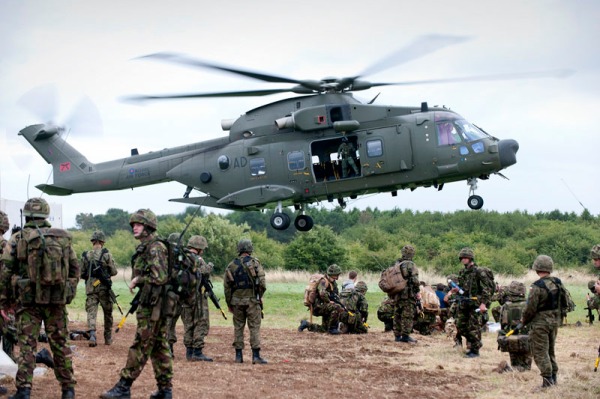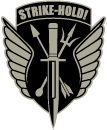RAF Merlins get ready for Afghanistan
In Iraq Merlins proved their worth. Now the RAF prepares its helicopters and crews for the challenge of Afghanistan.
With all RAF aircraft out of Iraq, the priority is now to get all available helicopters to troops in Afghanistan.
The Merlin – used mainly to move troops and supplies and evacuate casualties – should be there by the end of the year, increasing the number of UK helicopters by 25 per cent.

Merlin HC3 preparing to take-off.
[Picture: SAC Martin ‘Taz’ Hetherington, Crown Copyright/MOD 2005]
Preparation for the Merlins’ new mission began at RAF Benson. First the helicopters and crews must be made ready to operate in the harsh conditions of Afghanistan:
“Afghanistan and Iraq are very different theatres, so we’ve got a series of modifications to make to enable the aircraft to cope with the different conditions and threats they will face out there,” said Wing Commander Ross Richards, who is overseeing preparation of the Merlins at RAF Benson.
“Adding the heat and the increase in altitude together, the aircraft has to work harder – the air is thinner and they have to work closer to the edge of their performance envelope.”
To help them cope with the demands of Afghanistan the helicopters will be fitted with new rotor blades that are more effective in the heat and improvements will be made to the defensive aid suite, which safeguards the aircraft from threats on the ground.
Pilots and crewmen must also be trained to operate the upgraded Merlins in tough conditions:
“The engines become more limited and less responsive in the thinner air so you have to be more careful and think about how heavy you are – and remember it’s not just another sunny day at Benson,” said Flight Lieutenant Ross Norman, a helicopter pilot.
Also, in Iraq the areas we were working in were mostly flat deserts and open land or urban areas; Afghanistan is very different.”
Merlin crews will head to a US air base in the California desert to practise flying in the heat at altitude.
Pilots will fly similar profiles to those they will experience in Afghanistan, both during the day and at night. Ground crew and engineers will practise stripping down the helicopters so they can be transported in the RAF’s C-17 aeroplanes, before rebuilding them:
“We didn’t have to do that for Iraq because the crew were able to fly there but with Afghanistan the distance is too far,” said Station Commander Group Captain Jonathan Burr.
The Merlins fit into the C-17s with just inches to spare when the rotor blades and part of the gearbox have been removed. The whole exercise takes two to three days to perform:
“That along with the heat and altitude are the major challenges that we face, and of course there’s the threat level out there too,” said Group Captain Burr.

An RAF Merlin Mk 3a Helicopter prepares to embark Troops from 1st Battalion, The Coldstream Guards, during Operation JANUB AGHZAI, during 11 Light Brigade's Mission Rehearsal Exercise (MRX) on Salisbury Plain, Wiltshire on Saturday 18th July, 2009.
[Picture: Sgt Rob Knight RLC, Crown Copyright/MOD 2009]
RAF Merlin helicopters
- S3 Rolls Royce / Turbomeca RTM-322 turbine engines
- length: 74ft 10 inches (22.8m)
- rotor diameter: 61ft (18.6m)
- top speed: 192mph (309km/h)
- crew: one pilot and one navigator or two pilots, and two crewmen
- main role: movement of troops (up to 24 combat-equipped troops) and equipment around the battlefield and casualty evacuation
This article is taken from the October 2009 edition of Defence Focus.
About this entry
You’re currently reading “RAF Merlins get ready for Afghanistan,” an entry on Strike - Hold!
- Published:
- 01/10/2009 / 15:21
- Category:
- Afghanistan, Battlefield Mobility
- Tags:

No comments yet
Jump to comment form | comment rss [?] | trackback uri [?]